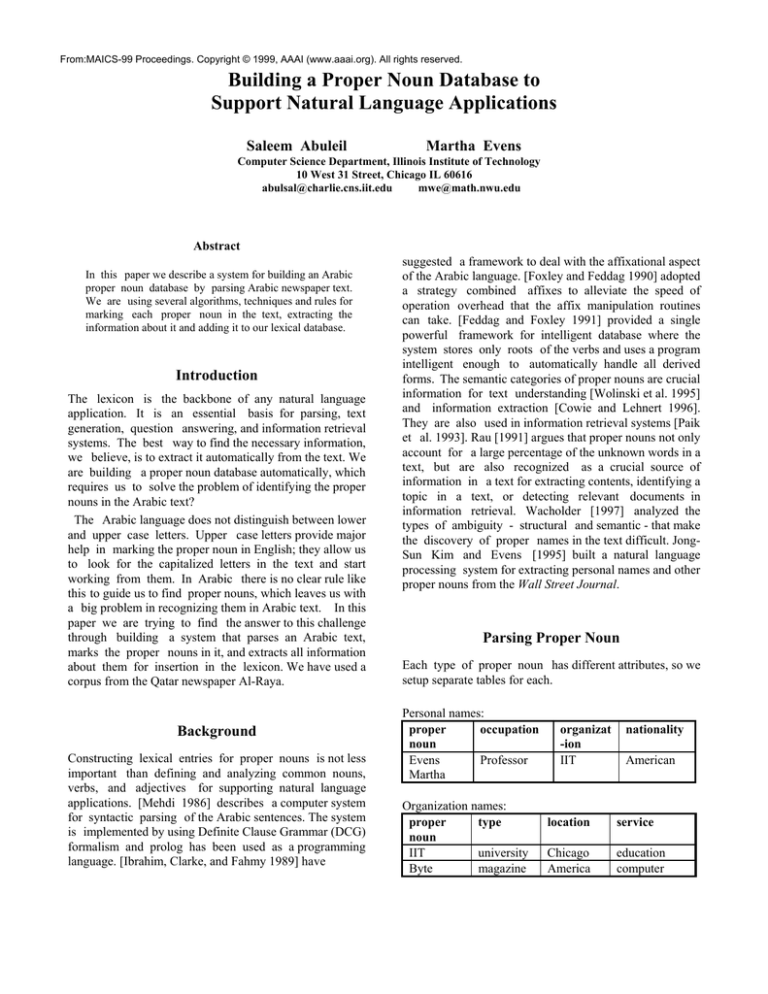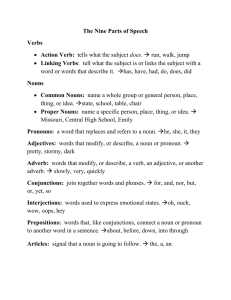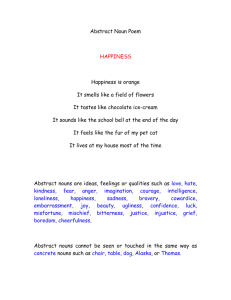
From:MAICS-99 Proceedings. Copyright © 1999, AAAI (www.aaai.org). All rights reserved.
Building a Proper Noun Database to
Support Natural Language Applications
Saleem Abuleil
Martha Evens
Computer Science Department, Illinois Institute of Technology
10 West 31 Street, Chicago IL 60616
abulsal@charlie.cns.iit.edu
mwe@math.nwu.edu
Abstract
In this paper we describe a system for building an Arabic
proper noun database by parsing Arabic newspaper text.
We are using several algorithms, techniques and rules for
marking each proper noun in the text, extracting the
information about it and adding it to our lexical database.
Introduction
The lexicon is the backbone of any natural language
application. It is an essential basis for parsing, text
generation, question answering, and information retrieval
systems. The best way to find the necessary information,
we believe, is to extract it automatically from the text. We
are building a proper noun database automatically, which
requires us to solve the problem of identifying the proper
nouns in the Arabic text?
The Arabic language does not distinguish between lower
and upper case letters. Upper case letters provide major
help in marking the proper noun in English; they allow us
to look for the capitalized letters in the text and start
working from them. In Arabic there is no clear rule like
this to guide us to find proper nouns, which leaves us with
a big problem in recognizing them in Arabic text. In this
paper we are trying to find the answer to this challenge
through building a system that parses an Arabic text,
marks the proper nouns in it, and extracts all information
about them for insertion in the lexicon. We have used a
corpus from the Qatar newspaper Al-Raya.
Background
Constructing lexical entries for proper nouns is not less
important than defining and analyzing common nouns,
verbs, and adjectives for supporting natural language
applications. [Mehdi 1986] describes a computer system
for syntactic parsing of the Arabic sentences. The system
is implemented by using Definite Clause Grammar (DCG)
formalism and prolog has been used as a programming
language. [Ibrahim, Clarke, and Fahmy 1989] have
suggested a framework to deal with the affixational aspect
of the Arabic language. [Foxley and Feddag 1990] adopted
a strategy combined affixes to alleviate the speed of
operation overhead that the affix manipulation routines
can take. [Feddag and Foxley 1991] provided a single
powerful framework for intelligent database where the
system stores only roots of the verbs and uses a program
intelligent enough to automatically handle all derived
forms. The semantic categories of proper nouns are crucial
information for text understanding [Wolinski et al. 1995]
and information extraction [Cowie and Lehnert 1996].
They are also used in information retrieval systems [Paik
et al. 1993]. Rau [1991] argues that proper nouns not only
account for a large percentage of the unknown words in a
text, but are also recognized as a crucial source of
information in a text for extracting contents, identifying a
topic in a text, or detecting relevant documents in
information retrieval. Wacholder [1997] analyzed the
types of ambiguity - structural and semantic - that make
the discovery of proper names in the text difficult. JongSun Kim and Evens [1995] built a natural language
processing system for extracting personal names and other
proper nouns from the Wall Street Journal.
Parsing Proper Noun
Each type of proper noun has different attributes, so we
setup separate tables for each.
Personal names:
proper
occupation
noun
Evens
Professor
Martha
Organization names:
proper
type
noun
IIT
university
Byte
magazine
organizat
-ion
IIT
nationality
American
location
service
Chicago
America
education
computer
Location (political names):
proper
type
noun
Chicago
city
Illinois
state
USA
country
location
language
Illinois
America
World
English
English
English
Location (natural geographical names):
proper noun
type
location
Nile
river
Africa
Atlantic
ocean
world
Times:
proper noun
September
Christmas
part-of
months
holidays
located-at
9th
December
Products:
product name
Toyota
Compaq
kind-of
vehicle
computer
made-in
Japan
America
Events:
eventname
Al-Kitab
Madrid
type
place
year
exhibition
conference
Egypt
Aspen
1995
1993
specialist-on
books
peace
Category (nationality, language, religion, ethnic, party,
etc.):
proper noun
type
related-to
American
nationality
America
Arabic
language
Arabs
The Arabic language does not distinguish between
upper/lower case letters like the English language. This
makes it not nearly as easy to locate proper nouns in
Arabic text as in English text. For this reason we will use
another technique for tagging the proper nouns in the text.
This technique depends on the keywords. We have
studied, analyzed, and classified these keywords, to use
them to guide us in tagging the proper nouns in the text
and figuring out the types and the features. We have
classified these keywords as follows:
Personal names (title): Mr. John Adams
Personal names (job title): President John Adams
organization names: Northwestern University
Locations (political names): State of Illinois
Location (natural names): Lake Michigan
Times: Month of September
Products: IBM Computer
Events: Exhibition of Egyptian books
Category: Arabic Language
We have also developed a set of grammatical rules to
parse the proper noun phrases in the text:
LPNP SPNP K/W SPNP
| K/W SPNP SPNP
| SPECAIL-VERB SPNP
| SPNP
SPNP K/W-PERSON LPN-OCCUPATION
| K/W-PERSON
LPN-TITLE
| K/W-ORG-LOC LPN-ORG-LOC-1
| K/W-ORG-LOC LPN-ORG-LOC-2
| K/W-PRODUCT LPN-PRODUCT
| K/W-PRODUCT LPN-PRODUCT
| K/W-TIME
LPN-TIME
| K/W-EVENT LPN-EVENT
| K/W-EVENT
LPN-EVENT
| K/W-CATEGORIES LPN-CATEGORIES
| K/W-CATEGORIES LPN-CATEGORIES
LPN-OCCUPATION K/W-ORG/LOC PN-ORG/LOC
PN-PERSON
| K/W-ORG/LOC PN-ORG/LOC
| PN-ORG/LOC PN-PERSON
| PN-ORG/LOC
| K/W-ORG/LOC PN-ORG/LOC PNPERSON
| K/W-ORG/LOC PN-ORG/LOC
LPN-TITLE PN-PERSON
| ADJECTIVE
| ADJECTIVE PN-PERSON
| PN-PERSON ADJECTIVE
| ADFPN
| ADFPN
PN-PERSON
| ADFPN
ADJECTIVE
| ADFPN
ADJECTIVE PN-PERSON
| ADFPN PN_PERSON ADJECTIVE
LPN-ORG-LOC-1 ADJECTIVE
| ADJECTIVE PN-LOC-ORG
| ADFPN
| ADFPN PN-ORG-LOC
| ADFPN ADJECTIVE
| ADFPN ADJECTIVE PN-ORG-LOC
LPN-ORG-LOC-2 PN-ORG-LOC
| PN-ORG-LOC ADJ
| PN-ORG-LOC ADFPN
| PN-ORG-LOC ADFPN ADJ
| PN-ORG-LOC ADJ ADFPN
| PN-ORG-LOC PN-PERSON
| PN-ORG-LOC ADJ PN-PERSON
| PN-ORG-LOC ADFPN PN-PERSON
LPN-PRODUCT PN-PRODUCT
| ADFPN | ADJ
| PN-PRODUCT ADFPN
| PN-PRODUCT ADJ
| PN-PRODUCT ADFPN ADJ
| ADJ
PN-PRODUCT
| ADFPN
PN-PRODUCT
LPN-TIME PN-TIME
| PN-TIME PN-TIME
LPN-EVENT PN-EVENT1 NP
| PN-EVENT1
LPN-EVENT1 PN-EVENT
| ADJ | ADFPN
| PN-EVENT
ADJ
| ADFPN
ADJ
| ADFPN
PN-EVENT
NP NOUN
LPN-CATEGORIES PN-CATEGORIES
|
ADFPN
ADFPN (ADJECTIVE DERIVED
FROM PROPER NOUN)
The () is the determiner in the Arabic language, it tells
whether the proper nouns come right next to the keyword
or not.
classify it, and with respect to this classification run a
certain algorithm to generate the token.
Recognizer for Proper Noun Phrases
From our analysis of Al-Raya newspaper text we have
categorized the proper nouns with respect to the way they
occur in the text into three categories: proper nouns that
start with a keyword, proper nouns that end with a
keyword and proper nouns without an adjacent keyword.
We have implemented this system for proper noun phrases
that start with a keyword, end up with one of the
following: verb, particle, pronoun, auxiliary verb or
punctuation mark, and include one or more of the
following: keywords, proper noun, adjective, adjective
derived from proper noun, word of unknown type. Figure
2 shows how this system works.
Get next token
from tokenizer
no
Keyword yes Get next
token
Parser System
Our system consists of three main subsystems beside the
lexical database as shown in Figure 1.
Lexico
DOCUMENT
TOKENIZER SYSTEM
lexicon
Parse
proper noun phrase
no
Figure 2: Recognizer for Proper Noun Phrases
PRPER NOUN PHRASE
RECOGNIZER
PROPER NOUN
PHRASE PARSER
yes
Part of the
proper noun
phrase
PN
database
Figure 1: Organization of the Parser
Tokenizer System
We have implemented an algorithm that can isolate the
punctuation marks as well as isolate the extra particles
attached to the beginning of the word, while they are not
part of it. We have classified the words in the Arabic
language into eight categories with respect to their
prefixes. This system caries out three main steps: Isolate
the word from the text, pass it to a certain algorithm to
Parser for Proper Noun Phrase
This system is responsible for parsing proper noun phrases
to mark the proper nouns, find their features, and extract
further information. This system uses two techniques to
accomplish this task, a set of grammatical rules to mark
the proper noun and to extract the information about it and
the keyword to find the type and features.
Example:
!"#$%
&'('
Mrs. Diana president of American)s South University
made a visit to the big computer exhibition in Chicago
American South
university
president Diana Mrs.
!"#
ADFPN
PN
K/W
SHORT
PN
PHRASE
K/W
K/W
PN
K/W
SHORT
PN
PHRASE
result: the actual proper nouns in the text (isolated proper
noun or proper noun with adjacent keyword) are 175, the
first part of the system (proper noun phrases recognizer)
which is responsible for marking the proper noun phrases,
found 152 - 87% of the proper noun phrases (see Figure
4). The second part of the system (proper noun phrases
parser) which is responsible for parsing the proper noun
phrases, found 147 proper nouns, this amounted to 96% of
the proper noun phrases that are found by the first system
(proper noun phrases recognizer) see Figure 5, and 84%
of the total number of proper nouns in the text. In
summary total the parser system by using both the proper
noun phrase parser and the accumulated proper noun
database, the one that we are building, found and marked
161 or 92% of the total number of proper nouns in the text
(see Table 1).
LONG PN PHRASE
175
actual proper
nouns in the text PN: proper noun. K/W: keyword
ADFPN: adjective derived from PN
Databases
We are using two kinds of databases to assist the system.
The first database contains the words, their types, and their
features. This is the lexical database that developed by
Abuleil and Evens [1998]. The second database is the one
that we are building for the proper nouns. It contains main
table with all the proper nouns, the proper noun itself, the
type (person, organization, location, group, time, event)
and the gender (male or female), and there are additional
tables connecting to the main table each one with
information about one type of proper noun as shown in
Figure 3.
PEOPLE
ORGANIZATION
EVENT
MAIN
TABLE
POLITICAL
LOCATION
TIME
PRODUCT
NATURAL
LOCATION
CATEGORY
152 - 87%
proper noun
phrases found
by
PNP recognizer
23 - 13%
proper noun
phrases not
found by
PNP recognizer
Figure 4: Proper Noun Phrase Recognizer System
152
actual proper
nouns in the text 147 - 96%
proper nouns
marked by
PNP
parser
5 - 4%
proper nouns
missed
by PNP
parser
Figure 3: The Proper Noun Tables
Figure 5: Proper Noun Phrase Parser System
Results
We have tested the system on 40 articles from a corpus
developed by Ahmad Hasnah[1996] based on text given to
Illinois Institute of Technology, by the newspaper, AlRaya, published in Qatar. We have got the following
PN in
PN marked by
the text
Parser System
175
161 - 92%
Table 1: Proper Nouns Marked by the Parser System
our parser also produced a few garbage nouns, that the
parser marked as proper nouns though they are not. The
problem is that in some cases the parser could not
distinguish between proper noun and some other special
adjectives and nouns. We believe that we will reduce this
problem as we parse more text and identify the special
words that create this difficulty.
Conclusion
In order to build a large database of Arabic proper nouns
automatically we have classified the proper nouns in the
Arabic language into different categories and used a new
technique to tag them from the Arabic text by using
keywords. We developed a set of grammatical rules for
this purpose. We have developed a system using these
rules that extracts the proper nouns and the information
about them from newspaper text.
References
Abuleil, S. and Evens, M., 1998. Discovering Lexical
Information by Tagging Arabic Newspaper Text.
COLING-ACL98, 1-7. University of Montreal, Quebec,
Canada, Aug 16 1998.
Cowie, J., and Lehnert, W., 1996. Information Extraction
Comm, of the ACM 39(1):83-92.
Elmi. M. A. 1994. A Natural Language Parser with
Interleaved Spelling Correction Supporting Lexical
Functional Grammar and Ill-Formed Input, Unpublished
Ph.D. Dissertation, Computer Science Department, Illinois
Institute of Technology, Chicago IL.
Feddag, A., Foxley, E., 1991. An Intelligent Lexical
Analyzer for Arabic and English. 13th Research
Conference on Information Retrieval. British Computer
Cociety (BCS). Lancaster University, 8-9th April, UK.
Foxley, E., Feddag, A., 1990. A Syntactic and
Morphological Analyzer of Arabic Words. Proceedings of
the Second International Conference on Computing in
Arabic-English. Cambridge University, UK.
Hasnah, A., 1996. Full Text Processing and Retrieval:
Weight Ranking, Text Structuring, and Passage Retrieval
For Arabic Documents. Ph.D. Dissertation, Illinois
Institute of Technology, Chicago, IL.
Ibrahim, A., Douglas, J., Fahmy, A., 1989. Arabic
Machine Translation. Proceedings of the First
International Conference in Computing in Arabic-English.
Cambridge University, UK.
Kim, J-S., and Evens, M., 1995. Extracting Personal
Names from the Wall Street Journal. Proceedings of the 6th
Midwest Artificial Intelligence and Cognitive Science
Society Conference, 78-82. Carbondale, IL, April 21-23.
Mehdi, S. A. 1986. Arabic Language Parser, International
Journal of Man-Machine Studies. 25(5):593-611.
Paik, W., Liddy, E. D., Yu, E., and Mckenna, M., 1993.
Categorizing and Standardizing Proper Nouns for Efficient
Information Retrieval. In B. Boguraev and J. Pustejovsky
44-54. eds, Corpus Processing for Lexical Acquisition,
Cambridge, Mass.: MIT Press.
Rau, L. F., 1991. Extracting Company Names from Text.
Proceedings of the Seventh Conference on Artificial
Intelligence Applications, 29-32. Feb. 24-28, Miami
Beach, Florida.
Wacholder, N., Ravin, Y., and Choi, M., 1997.
Disambiguation of Proper Names in Text. Proceedings of
the Fifth Conference on Applied Natural Language
Processing, 202-208. Mar 31- Apr 3, Washington, DC.
Wolinski, F., Vichet, F., and Dillet, B., 1995. Automatic
Processing of Proper Names in Text. Proceedings of the
7th Conference of the European Chapter of the Association
for Computational Linguistics, 23-30. Dublin, Ireland.








